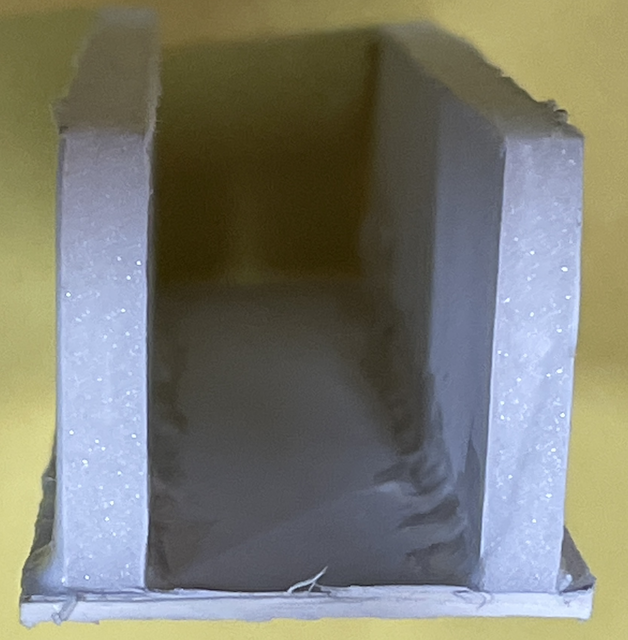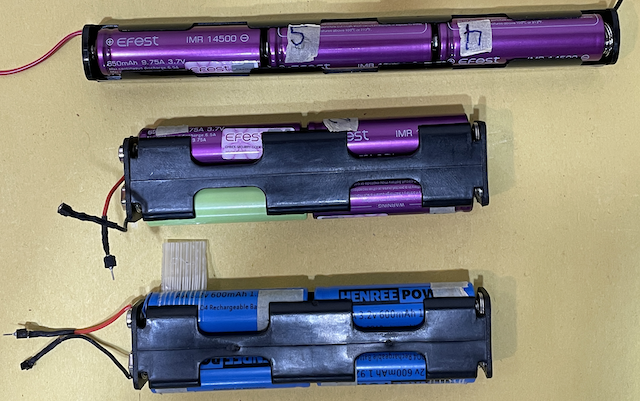Updated: End of August 2025 Many people do not have very much specific knowledge regarding the batteries used in their daily lives, they just use them as described by the device provider. I have provided a brief bit of information regarding what a battery is, how it works, and how series and parallel battery connections affect the battery's voltage and capacity. The typical 1.5 volt (V) alkaline battery is used for a size comparison to Lithium-ion cylindrical batteries, although it is not used for my KISS Dead Rail system. Batteries for my RC planes use rechargeable, fairly small, light weight and low capacity, Lithium-Polymer, pouch, Lithium Cobalt Oxide (LCO) batteries in my smaller RC planes, Two sizes of rechargeable, Lithium Iron Phosphate (LiFePO4) cylindrical batteries are used in my larger RC planes. The term rechargeable battery implies that once the electrical energy, created by an electrochemical reaction in a battery, has been used up, there is a relatively safe means for the user to replace that energy by an opposite electrochemical reaction caused by "charging". I first became aware of cylindrical Lithium-ion and Lithium-polymer pouch batteries at the end of 1992. Bill Ray, from Longwood, FL sent me an article from the Wall Street Journal, which I paraphrased and put in my January 1993 issue of the Ampeer. (Note: I forgot to change the header, but it is the January 1993 issue, not 1992.) The word "Lithium" is found in the description of Lithium-ion and Lithium-polymer batteries. BOTH TYPES ARE LITHIUM-ION! Pouch cells are most typically called LiPo batteries or LiPoly batteries. Cylindrical batteries are most often just called Lithium-ion batteries. Both types of the batteries are lithium-ion, differing in their specific cathode chemistry, the anode type and the construction and type of "container". Many people are not familiar with the various container types and cathode chemistries of Lithium-ion batteries and their implications on the safe usage of Lithium-ion batteries. Many, many people tend to "lump" all types of Lithium-ion batteries together. In my opinion, THIS IS A VERY POOR PRACTICE. Understanding the various types of Lithium-ion batteries is extremely important in choosing specific battery types for use in Dead Rail applications. My article, Lithium-based Batteries - What YOU Need to Know provides essential Lithium-ion battery information for Dead Rail users. Some Lithium-ion batteries are available with a protection circuit module (PCM) added to the cell/battery. The PCM protects the battery against very high charging voltages, very low discharging voltages, and high currents during discharging (short circuits). It also adds more mass to the "battery" and is not usually available on the smaller sizes of Lithium-ion batteries. Many times, these types are known as "protected" batteries. Sometimes a battery management system (BMS) is added to a battery pack. "A battery management system can be comprised of many functional blocks including: cutoff FETs, a fuel gauge monitor, cell voltage monitor, cell voltage balance, real-time clock (RTC), temperature monitors, and a state machine. There are many types of battery management ICs available." It is sometimes added by a battery provider to a pack, at other times it is a discrete component that is added by the user. To keep to my KISS criteria, I wanted to use a battery without using batteries with PCMs or BMSs and still be as safe as possible. I chose not to use prismatic types of containers, or form factors, for the batteries, as they are not really practical for HO. They tend to be "large" and heavy. Lithium Titanate (Li4Ti5O12) or LTO), is the safest because of its cathode AND anode chemistry. Unfortunately, they are low in voltage, and therefore, it would take a lot of them to create a battery pack for model locomotives. They are also not readily available in a useful format. My Dead Rail research indicated that Lithium Polymer pouch batteries were the choice for many HO Dead Rail conversions that were found online. They were either used as a single battery with a "voltage booster" or wired together in series to achieve higher voltages for use with HO scale locomotives. On the other hand, probably because there is more room to "play with", O and G scale Dead Rail conversions, for the most part, tended to use some type of Lithium-ion cylindrical batteries, wired in series. The chemistry of the cylindrical batteries could not be ascertained. I noted that the lithium-polymer batteries, that I use for my planes, use some formula of lithium cobalt oxide (LCO) on the cathode. I do not know that to be a fact, but it is based on this statement, "The most common type of lipo battery cathode is made of lithium cobalt oxide (LiCoO2)." Lithium-polymer pouch batteries can use all of the various cathode chemistries. See the heading "LiPo chemistries" on this page. I found it impossible to find out what cathode chemistry is being used for other lithium-polymer pouch batteries, except for Lithium Iron Phosphate (LiFePO4, LiFe). The supplier, Hobby King, was chosen to illustrate these types of LiFe pouch batteries because they have a large selection of "brands". Note that for the RC hobby, they are only available in 2S (in series) and 3S (in series) packs. None of their packs are really small enough to fit into HO Dead Rail battery cars, but it does open up some interesting possibilities for O and G scale to use the safest lithium chemistry cathode. For my planes, I chose to use the safest lithium-ion cathode chemistry, Lithium Iron Phosphate cylindrical batteries, because they are in a somewhat more "crash" resistant container, provide the power I need for the type of flying I do and are still lighter than the equivalent power from NiCads and NiMH batteries. My use of these LiFePO4 batteries is NOT typical for most fliers of electrically powered model airplanes, helicopters and drones. Most of the pilots typically use LiPo batteries. I use two sizes of these LiFe batteries; the 18650 and 26650. I initially used the brand from A123 Systems, which later became Lithiumwerks batteries. In the world of cylindrical lithium batteries, 18650 describes the physical size of the battery with an approximate diameter of 18mm and approximate length of 65mm. A 26650 has an approximate diameter of 26mm and approximate length of 65mm. It is becoming somewhat common to drop the 0 and describe them as 1865 and 2665, but the older description, with the trailing 0, is still the most common. The trailing 0 indicates that it is a cylindrical Lithium-ion battery. A double A (AA) alkaline battery measures "13.5-14.5 mm in diameter and 49.2-50.5 mm in length", including the button terminal. That is equivalent to a cylindrical 14500 size lithium-ion battery. A triple A (AAA) alkaline battery measures "10.5 mm in diameter and 44.5 mm in length". That is equivalent to a cylindrical 10440 size lithium-ion battery. My initial Dead Rail conversion used a "stick of gum" shaped 3S (3 in series) 300mAh capacity, 3.7V nominal* voltage per cell, lithium-polymer pouch battery for a nominal 11.1V for the pack. That battery was chosen because it would fit inside a Walthers Trainline EMD GP15-1.
Another reason why it was chosen was because I already had a multi-chemistry balancing charger for the batteries used in my RC planes. A means to balance charge Lithium-ion batteries is necessary. "No two cells are identical. There are always slight differences in the state of charge, self-discharge rate, capacity, impedance, and temperature characteristics. This is true even if the cells are the same model, same manufacturer, and same production lot. Manufacturers will sort cells by similar voltage to match as close as possible, but there are still slight variations in the individual cells impedance, capacity, and self-discharge rate that can eventually lead to a divergence in voltage over time."
A good multi-chemistry lithium-ion battery charger, like mine for RC planes, uses two steps, or stages, to charge each individual cell (AKA battery). First is the constant current stage which then moves to a constant voltage stage where the current decreases to a specified setting. It is called cc/cv charging.
The lithium-polymer pouch battery, that I originally used, proved to be a problematic choice from the beginning. It was a very bad choice from a cathode chemistry safety point. It required extensive modification to the locomotive's shell to make the shell removable, and the shell never became easily removable. It required modification to the battery's charging and balancing leads. The battery and the LocoFiTM module/decoder, with attached speaker, just barely fit inside the shell. This proved not to be a practical method for me to go Dead Rail. Research indicated the use of a trailing battery car was quite common in HO Dead Rail conversions and even in O and G scale Dead Rail. Before selecting a cathode chemistry type and physical size of cylindrical battery, I reviewed what I had learned from using LocoFiTM with the 3S 300mAh 11.1V (nominal) lithium polymer pouch battery. As part of the locomotive setup, the LocoFiTM App uses speed steps to set the speed performance parameters and display the scale mph on screen. The App can create speed tables using 1 Step, 7 Steps and 15 Steps. Only a 1 Step speed table is required to obtain the highest voltage and thus the top speed that can be reached at that voltage. The 7 Step and 15 Step tables provide more accurate "in-between" voltage tables that are useful for consisting. The full scale EMD GP15-1 had a top speed of 65 mph. Using the 3S LiPo battery, there was enough excess voltage to set the maximum speed, a feature of the App, to 65 mph. Therefore, three 3.7V cylindrical batteries, wired in series, could be used. The 3S 300mAh LiPo could power the locomotive, on my flat layout, while pulling six or seven pieces of rolling stock for close to one hour of prototypical run time. The physical measurements of the two HO 50' boxcars and 53' gondola, that I use as battery cars, indicated that I could not use 18650 size batteries. They would not fit. That meant that I had to look for physically smaller batteries. Since 10440 size cylindrical Lithium-ion batteries are approximately the same physical size as triple A (AAA) batteries, and 14500 size are approximately the same size as double A (AA) batteries, that meant that I could use commercially available AAA and AA battery boxes instead of having to create my own battery packs. Many months were spent using various chemistry 10440 size batteries, as I didn't believe that AA size battery boxes would actually fit in the trailing battery cars. Two triple A (AAA) size battery boxes were wired in series and became a convenient away to create a 4 in series LiFe battery pack. Lithium manganese oxide (LiMn2O4, LMO, IMR) and Lithium nickel manganese cobalt oxide (LiNiMnCoO2 NMC, INR) 10440 size batteries required only a 3 in series battery pack to run an HO scale locomotive at scale speed. A "dummy" or "fake" AAA battery connector could be used in the fourth slot of the two 2 AA battery boxes wired in series. The Hisonde 4 Pack AAA Battery Placeholder Cylinder AAA Size Hot Dummy Fake Battery Setup Shell, on Amazon, is an example. This product is no longer available, but similar products are.
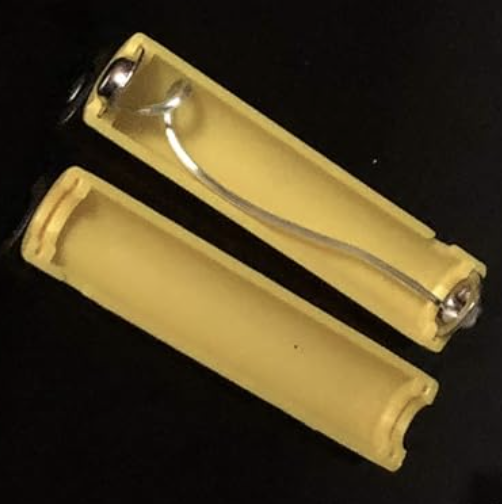 The photo shows a double A (AA) size, but the principle is the same in AAA size. After some time and experimentation, the Micro-Mark 32-pin Micro Connector turned out to be the connector of choice between the LocoFiTM module and battery car battery. (I no longer use any connectors between the decoder in the locomotive and battery box in the battery trailing car.) Using a battery box, with removable batteries, eliminated the need for any type of switch. The last battery inserted into the 4 battery battery box acted as an on switch and the removal of any of the batteries acted as an off switch. 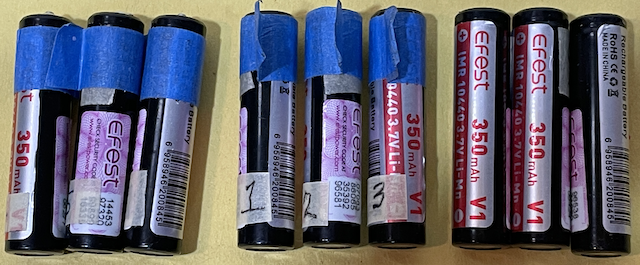 Some 10440 size Lithium Manganese Oxide (LMO/IMR) 350mAh capacity with a nominal voltage of 3.7V each were located and purchased. The LMO/IMR cathode chemistry was chosen for its relative safety. The 10440 size was chosen because triple A (AAA) size battery boxes could be used to create a series pack with enough voltage, a nominal 11.1V, to power the locomotive to its maximum speed in scale mph. The capacity was noted in the same range as the original LiPo, therefore the prototypical run time was about the same. 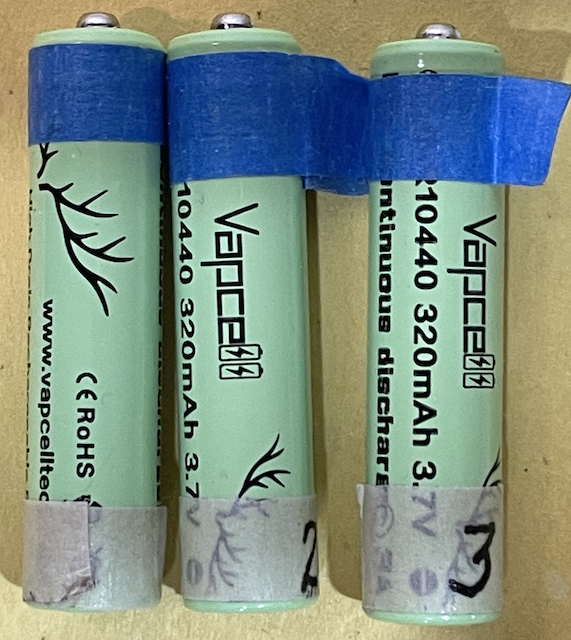 Unfortunately, 10440 size LMO/IMR batteries are no longer available. I now use three lithium nickel manganese cobalt oxide (NMC/INR) Vapcell 10440 size. Again, because of their relatively safe cathode chemistry.  The photo shows an early version of the battery box with a modified rear box. That is not necessary. A dummy battery connector can just be used in the 4th battery slot. In my RC planes, I use a 4 cell Lithium Iron Phosphate (LFP) to replace a 3S LiPo. The 4S LFP pack has a nominal voltage of 12.8V, which the LocoFiTM module can easily handle with its maximum of 24V.  A pack with the safest cathode chemistry, lithium iron phosphate (LiFe/IFR), using four 10440 size batteries was tried. No "fake" connector battery was necessary. 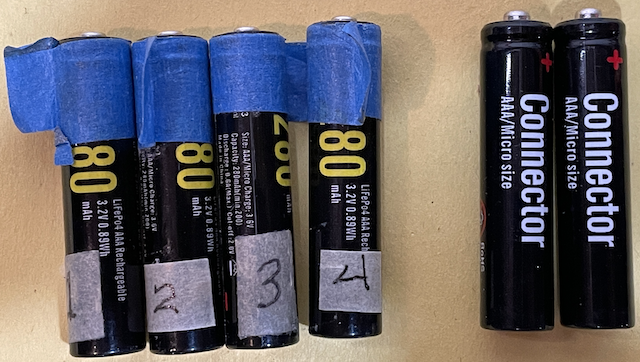 I tested the Soshine brand of LiFe batteries and the ones available from Only Batteries. Only the Soshine LiFePO4 have been found acceptable. The Soshine brand of LiFePO4 batteries are now only available directly from China via AliExpress. The 4 Soshine batteries achieved the same prototypical run time as the 3 LMO and NMC. The Soshine LiFe/IFR batteries came with two AAA fake connectors. The "Fake" connectors were not used as 4 LiFe batteries are about equal in nominal voltage to 3 nominal 3.6V or nominal 3.7V other types of Lithium-ion batteries. 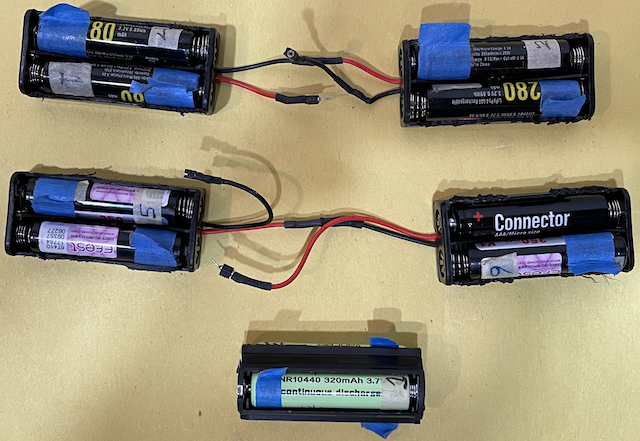 The photo shows the 10440 (AAA) size battery boxes, with the batteries, that I used. At the top of the photo 4 Soshine LiFe/IFR are shown. In the middle three Efest LMO/IMR and a "fake" battery type connector are shown. The bottom shows a 3 AAA battery holder with 3 Vapcell NMC/INR batteries in it. 3 Efest LMO/IMR and 3 Soshine LiFe/IFR are also used in this holder for the IHC 2-8-0 Consolidation. The tapes, that are seen in many of the battery photos, either number the batteries for future reference or are used as pull-tabs to help release the battery from the battery holder. 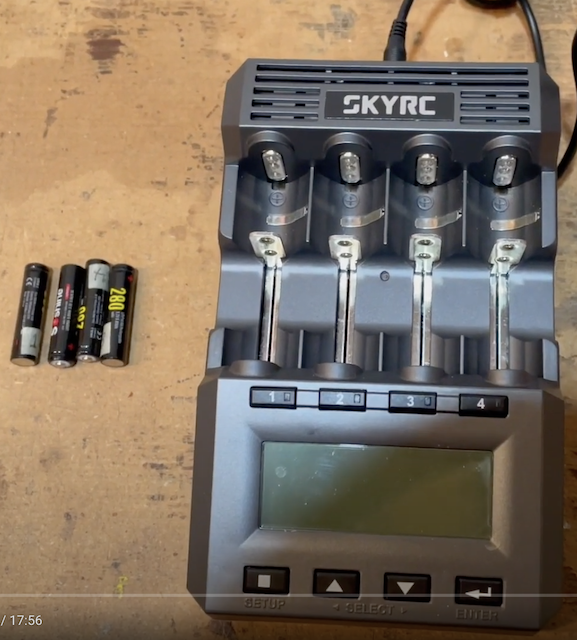 A SkyRC MC3000 cylindrical battery charger was used to cc/cv charge the three different types of Lithium-ion chemistries used. The individual batteries were charged outside the battery boxes. Charging them with this type of charger, also kept them in balance. More information regarding the SkyRC MC3000 can be found here. Charger information starts at the title, "Acceptable Battery Chargers", which is about 2/3 the way down the page. The charger displays the returned milliamp hours (mAh), which comes in handy when calculating the battery's prototypical run time. How to assess the prototypical run time is described here. Using 4 Soshine 10440 size Lithium Iron Phosphate, LiFePO4, (Life/IFR) batteries or 3 Lithium Manganese Oxide, LiMn2O4, (LMO/IMR), Efest 10440 batteries, provided the voltage required to run the EMD GP15-1s diesels to their maximum speed and provided approximately one hour of prototypical run time. Three 10440 size Vapcell NMC/INR batteries also provided approximately one hour of prototypical run time. AA (14500) size Lithium-ion Batteries Measurements of the 50' trailing boxcar and 53' gondola indicated that using any type of 4 AA battery battery box was very unlikely. That eliminated the use of 4 14500 Lithium Iron Phosphate, LiFePO4, (Life/IFR) batteries.l (Later this proved to be WRONG!) To increase the prototypical run time, an inline 3 double A (AA) size battery box was purchased. Efest (LMO/IMR) 14500 size (AA size) 650mAh batteries were purchased. The 14500 size Efest (LMO/IMR) batteries are still available as of July 2025.  The battery box did not work well with the button top Efest 14500 batteries. The fit was way too tight! Flat top LMO/IMR or NMC/INR batteries might work okay. Originally, I did not think that the 14500 size 4 AA battery box would work, because I thought that the battery boxes, with the batteries in them were too "wide" for the battery cars. In practice, this proved to be wrong. I purchased and tried a two side by side 4 battery battery box to hold 4 LiFePO4 batteries, to create the inherently safest battery. The box I chose lays flat in the 53' gondola and was originally "wedge" fitted in the 50' boxcar that I'm using, but it was a very snug fit.
 The method, shown here, for holding the 4 AA size battery box in place in the box car is no longer used. Because the battery fit in the boxcar was a bit fiddly, I created a battery box holder to fit on the frame of the boxcar. The battery box holder was created using two pieces of Dollar Tree Foam Board, for the sides, and a piece of Backing Board for the bottom. After the DTFB was glued to the Backing Board using Aleene's Tacky Glue, the sides of the bottom piece were sanded to fit perfectly on the frame top.

Battery Box Holder Installed on the Boxcar Frame The AA battery boxes came with connectors like those found on a 9V battery. The supplied connectors were not used on the first two installations. Micro-Mark micro connectors were used on one end of a 2" length of wire and the wire's other end was soldered directly to the terminals on the battery box. I no longer use the Micro-Mark connectors. Unfortunately, soldering directly to the battery box terminals didn't work out well as the very thin wire, from the locomotive to the trailing battery car, kept breaking at the solder joint to the battery box when the battery box was handled. The ALCO RS-3 with its battery boxcar containing 4 LiFe batteries. On the third battery box, the provided 9V connector was snapped onto the battery box and the wires from the loco soldered to the appropriate wires of the connector. This required only a slight modification to the battery box holder. The decoder used for this installation was a SoundTraxx Blunami Model BLU-21PINEM8 Digital Sound Decoder PN 885611 ALCO Diesel. 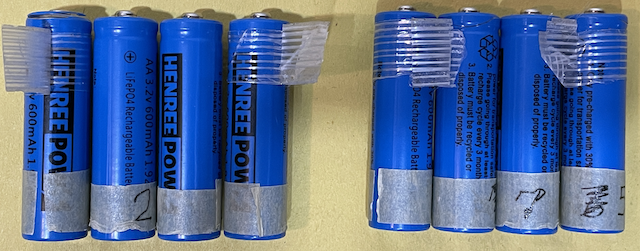 Originally, a four pack of Henreepow LiFePO4 3.2V 600mAh batteries, shown in the photo, were purchased through Amazon. As of July 2025, the four pack of these batteries was no longer available. This "safest" type of Lithium-ion cylindrical battery was tested and found to be acceptable. Four more of the Henreepow batteries were purchased to test the consistency of this "brand". They also tested well and were found to be acceptable. Both sets of batteries required a cycle on the charger before they were put into service. The testing procedure and results for the Henreepow batteries is found here. The four 14500 600mAh LiFe batteries provided up to two hours of prototypical run time on my layout with my diesel, GP15-1, locomotives. Surprisingly, the same four 14500 600mAh LiFe batteries provided 4 and 1/2 hours of prototypical run time when used with my Athearn RS3 being controlled by the Soundtraxx Blunami! On July 18, 2025, a 6 pack of the Henreepow batteries was ordered from Amazon.
 Since the AA 3 in-line box didn't work out well, 3 Efest LMO/IMR 650mAh were tried in the same type of 4 slot box as used by the 4 Life/IFR batteries. With the use of a dummy, or "Fake" battery, they worked well, as shown in the gondola. The fake battery is green.
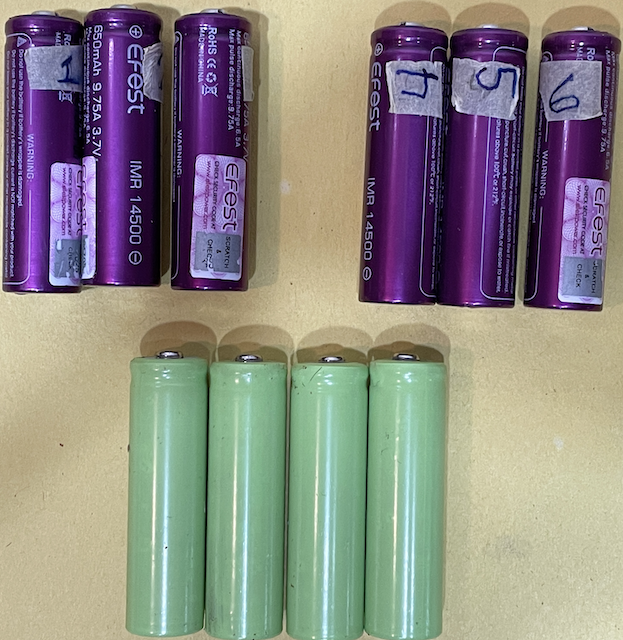
The holder, at the bottom of the photo, shows 4 Henreepow 14500 size LiFe/IFR in it. My IHC 2-8-0 Consolidation uses the tender as the battery car. That limits the battery holder to a 3 in series AAA battery holder.
The previously purchased 10440 (AA) size LMO/IMR and NMC/INR batteries are used, as well as 3 LiFe (IFR) 10440 size. While the 3 LiFePO4 batteries provide a lower voltage, it is still enough to reach the scale speed equivalent of 45 mph, which is the full-size 2-8-0's top speed of 45 mph. 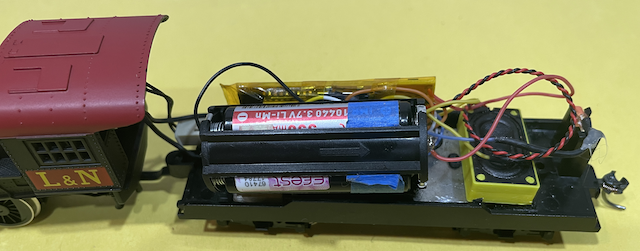 Three Efest IMR 10440 are shown mounted in the tender.
Batteries and Chargers That I Use for Dead Rail/Battery on Board - Original Info
|
